This post includes affiliate links. When you purchase through these links, we may receive a small commission at no extra cost to you. For full details, please see our affiliate disclosure page.
I’ve been thinking about writing a series of posts incorporating the ABCs of Travel which will get me (and hopefully) dreaming of traveling again. I begin with The Alhambra in Granada, Spain. As a travel blogger, this is what I do. I visit faraway places (or sometimes stay close to home) but I love to get on a plane and see someplace new. There is nothing wrong with taking day trips or explore the outdoors with hikes and walks which will keep us safely social distancing from each other. But for some of us, we want to dream about traveling far away.
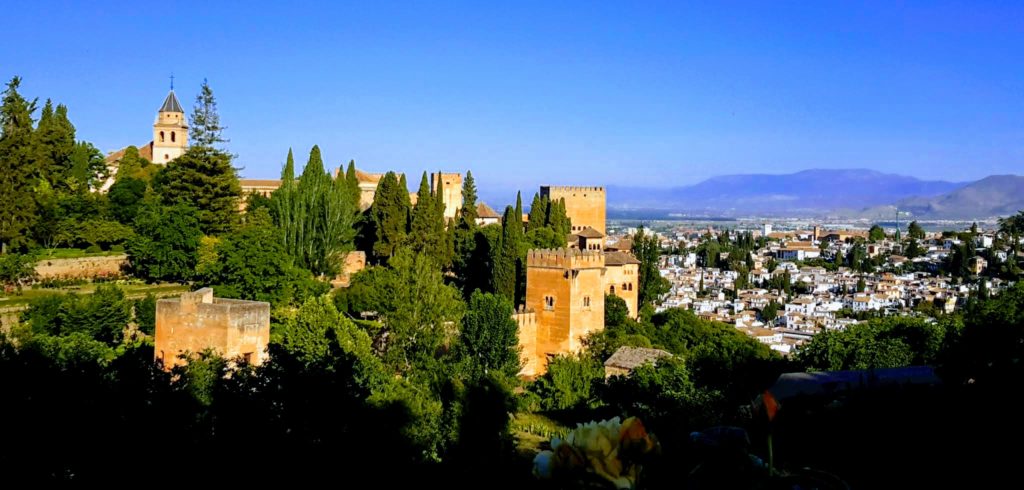
Whether you have done some ‘armchair travel’ seeing museums online or watching great shows on Netflix, you can continue to learn a little bit more about other countries or cultures while reading travel blogs.
🏡 Where to Stay: Top Accommodations
🥾 Explore: Tours & Experiences
🚙 Hit the Road: Car Rental Deals
🛫 Get Away: Find Flight Deals
🎒 Shop: Travel Essentials
You can also consider this looking at beautiful landscapes or awe-inspiring edifices in pictures. What these post will be are photo tours of some of the lovely places that I’ve traveled to in the last five years. Whether in Canada, America, Colombia, the Caribbean or Europe, I hope you enjoy my ABCs of Travel. We will begin in Andalusia, the southern state in Spain in the city of Granada.
A is for Alhambra in Granada
The Alhambra in Granada, an abbreviation of the Arabic: Qal’at al-Hamra, or red fort, was built by the Nasrid Dynasty (1232-1492)—the last Muslims to rule in Spain. Muhammad ibn Yusuf ibn Nasr (known as Muhammad I) founded the Nasrid Dynasty and secured this region in 1237. He began construction of his court complex, the Alhambra, on Sabika hill the following year.
With the Reconquista, King Ferninand II and Queen Isabella, reclaimed the state and it came into that hands of the Spanish once again in 1492. The mosque was replaced by a church and the Habsburg emperor Charles V had a wing of palaces demolished to make space for the huge Renaissance building that still bears his name.
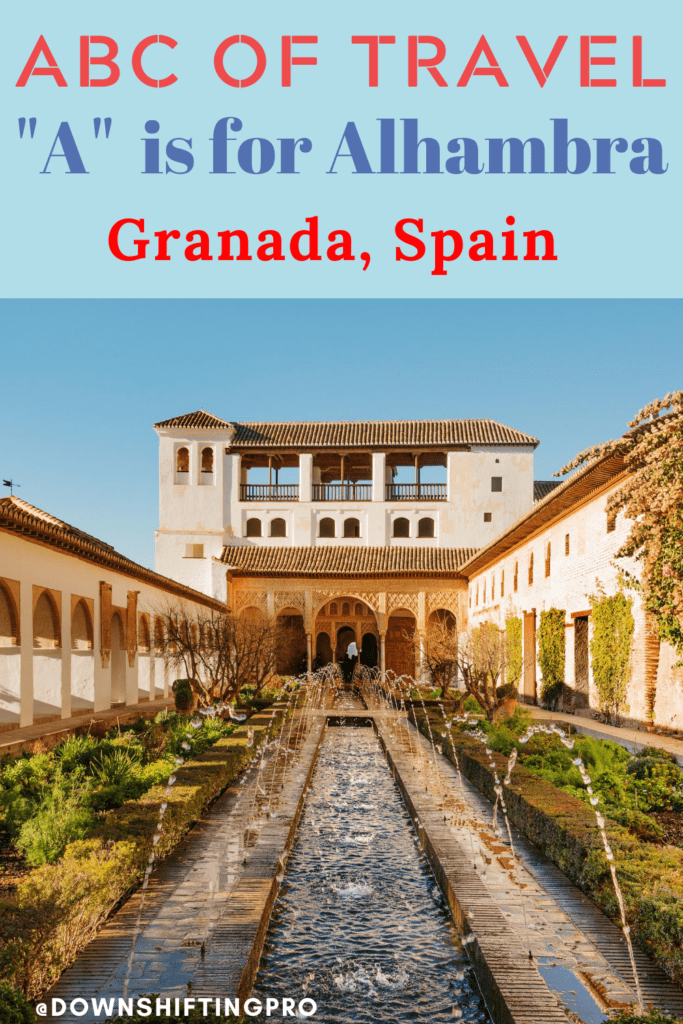
Insider’s Tip: Today the Alhambra in Granada is Spain’s most visited tourist attraction with millions of visitors each year. The best piece of advice I can give you is to purchase your tickets well in advance as there is a limit to the number of people admitted to the Nasrid Palaces per hour. Though you start outside of the fortress, your timed entry is for access to the Nasrid Palace.
Generalife Palace & Gardens
The Palacio de Generalife was the summer palace and country estate of the Nasrid rulers of the Emirate of Granada in Al-Andalus. This palace and gardens sits on the outside of the fortress. As you walk up from the entrance gate, you will see the Generalife before the entrance to the Nasrid Palaces, the Alcazaba and the Carlos V Palace.
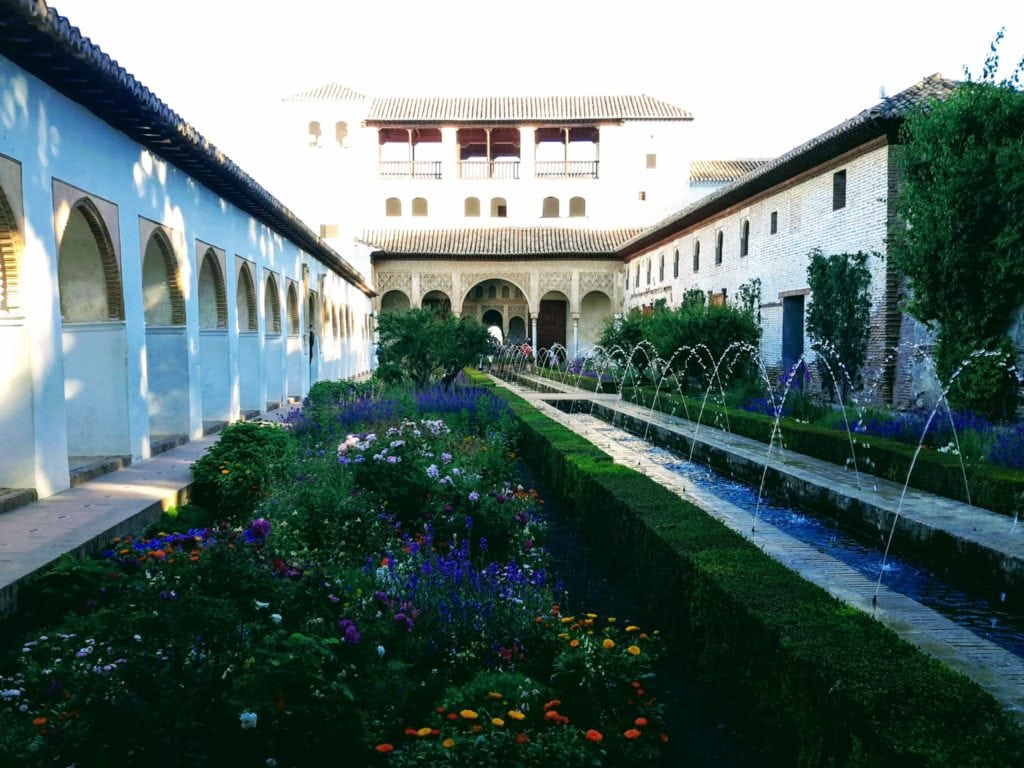
To the east on the Cerro del Sol (“Hill of the Sun”) is the Generalife constructed in the early 14th century as a summer palace. The complex is centred on picturesque courtyards such as the Patio del Ciprés de la Sultana (Court of the Sultana’s Cypress). Terraced gardens, pools, and fountains combine to enchanting effect in the Patio de la Acequia (Court of the Irrigation Channel), named for the channel that supplies its water. A theatre within the Generalife is the site of international performances of music and dance. The Alhambra and the Generalife were collectively designated a UNESCO World Heritage site in 1984 (expanded in 1994). Granada also became a UNESCO City of Literature in 2014.
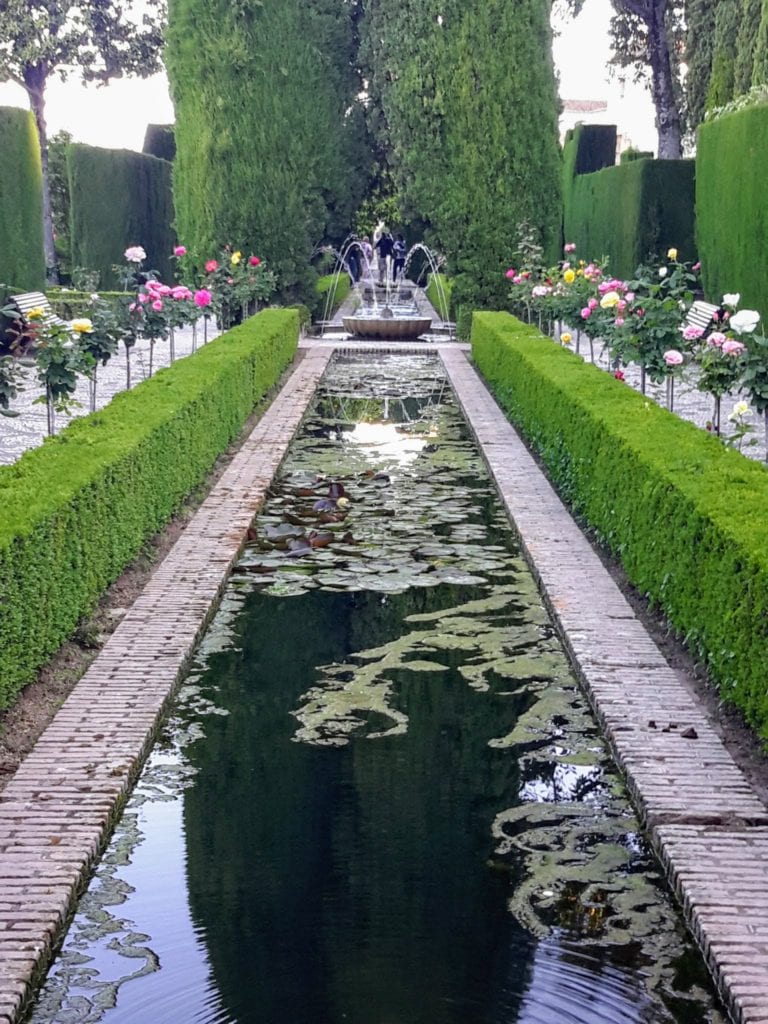
Palacios Nazaríes
Comares Palace
These courts are a series of palaces which at one point in history were independent of each other. Collectively they are the Palacios Nazaríes (Nasrid Palaces) but the Comares Palace is the official residence of the Sultan and then the Kings and Queens of Spain. As you enter through the Patio de los Arrayanes (Court of the Myrtles), you will enter into the Comares Palaces.
This elegant patio, named after the myrtle hedges surrounding the rectangular pool, is the central space of the palace built in the mid-14th century as Emir Yusuf I’s official residence. The reflective pool highlights the palace and provides a cooling effect in the hot summers and an insulating one in the winter.
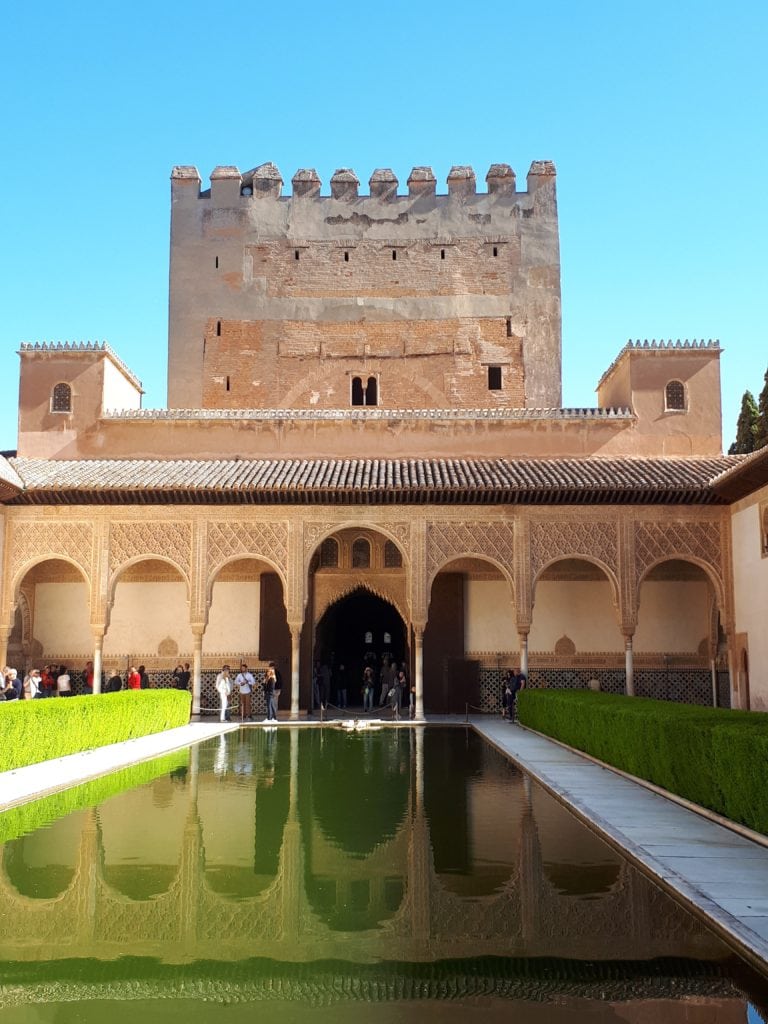
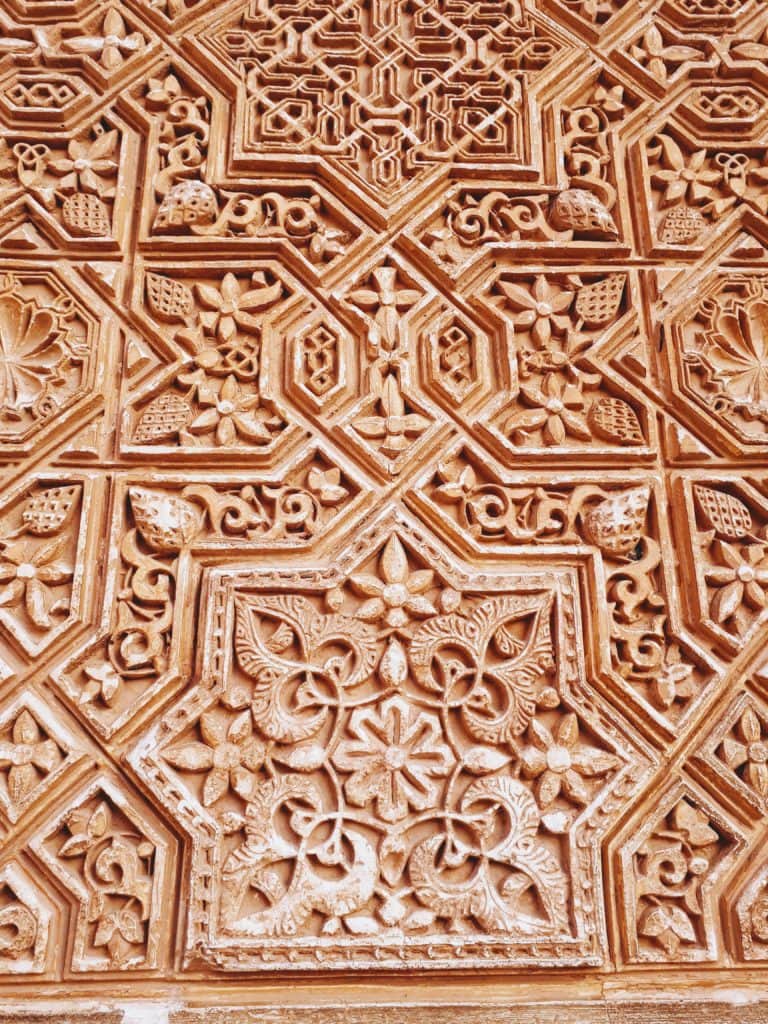
Hall of the Ambassadors
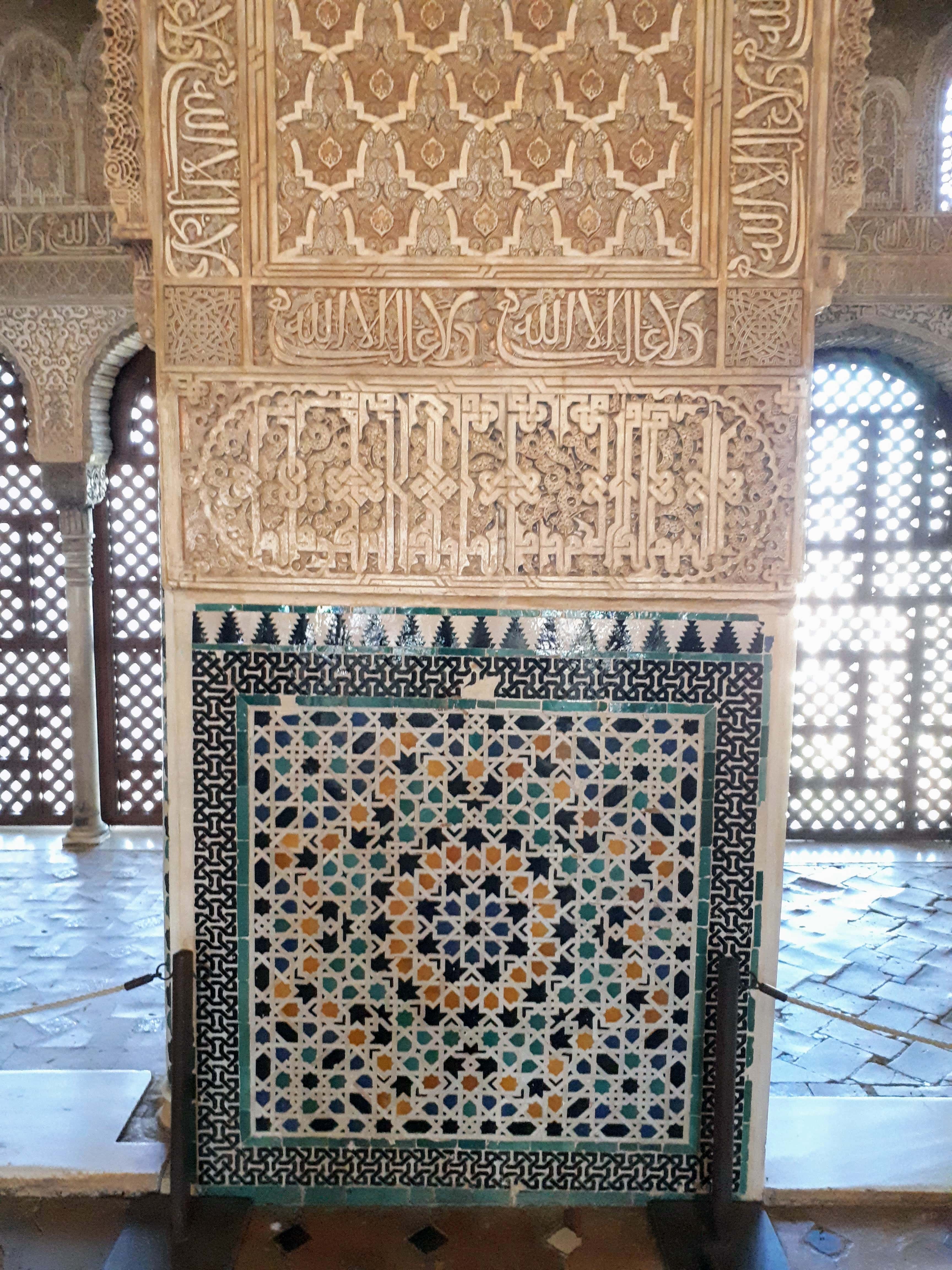
Inside this palace, you’ll find the Salón de los Embajadores (Hall of the Ambassadors) This room was where the emirs would have conducted negotiations with Christian emissaries. The walls are covered with etched scrolls and geometric patters. All with intricate mathematical patterns. This is stunning. The ornate detailing of the tiles and carvings is the ultimate balance of art and math.
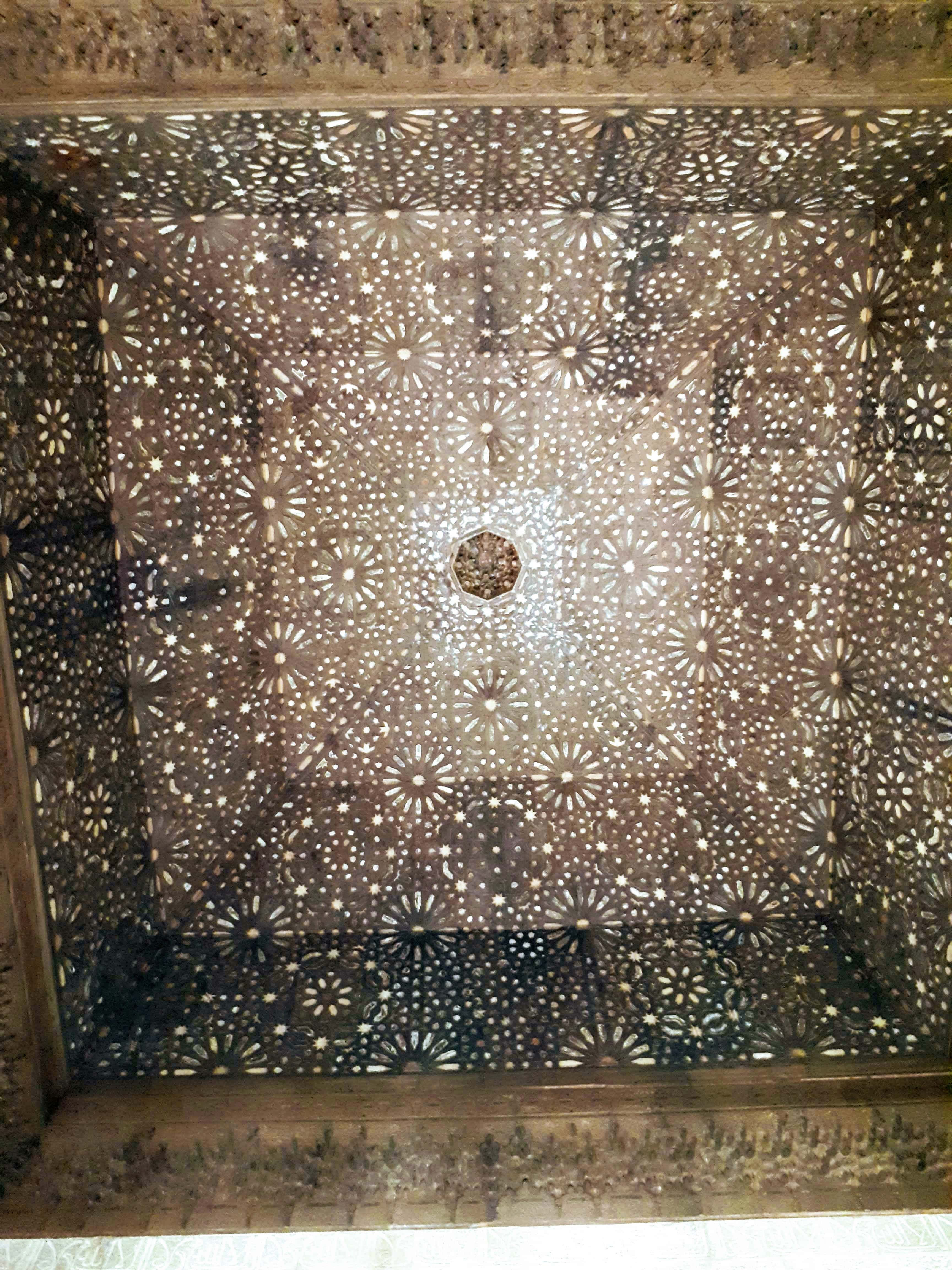
Eight thousand cedar wood pieces dominates the dome ceiling of the hall. The mosaic are meant to imitate a start-scattered night sky. The sultan intended it to represent the seven heavens of Islam. The Moors lived in harmony with both Christians and Jews in this area for 700 years and brought advanced engineering, math and science to the Alhambara.
Within the palaces you will see many tessellations (a series of tiles creating geometric patters – and optical illusions). A modern version of tessellations would be the artwork of M.C. Escher.
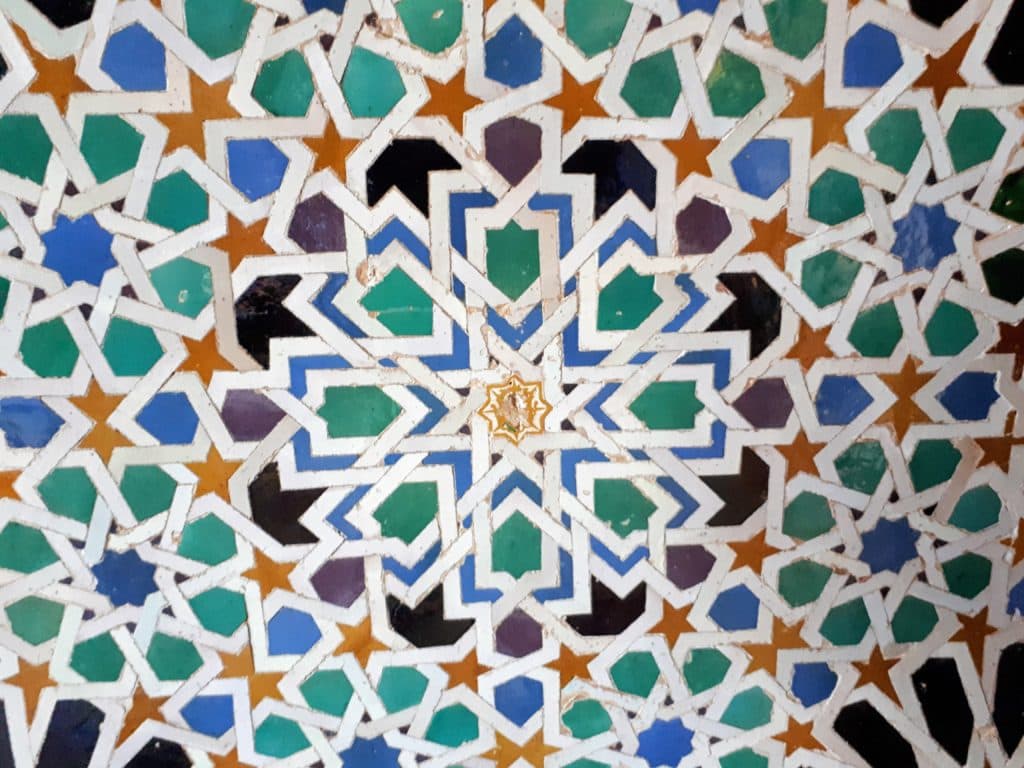
Court of the Lions
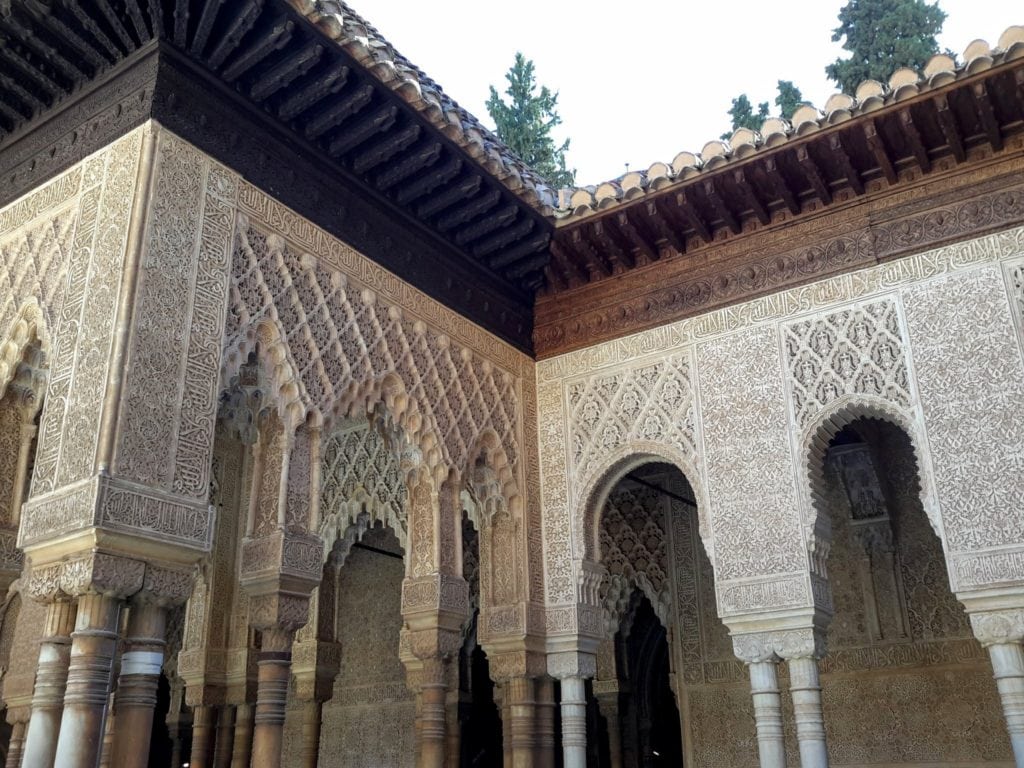
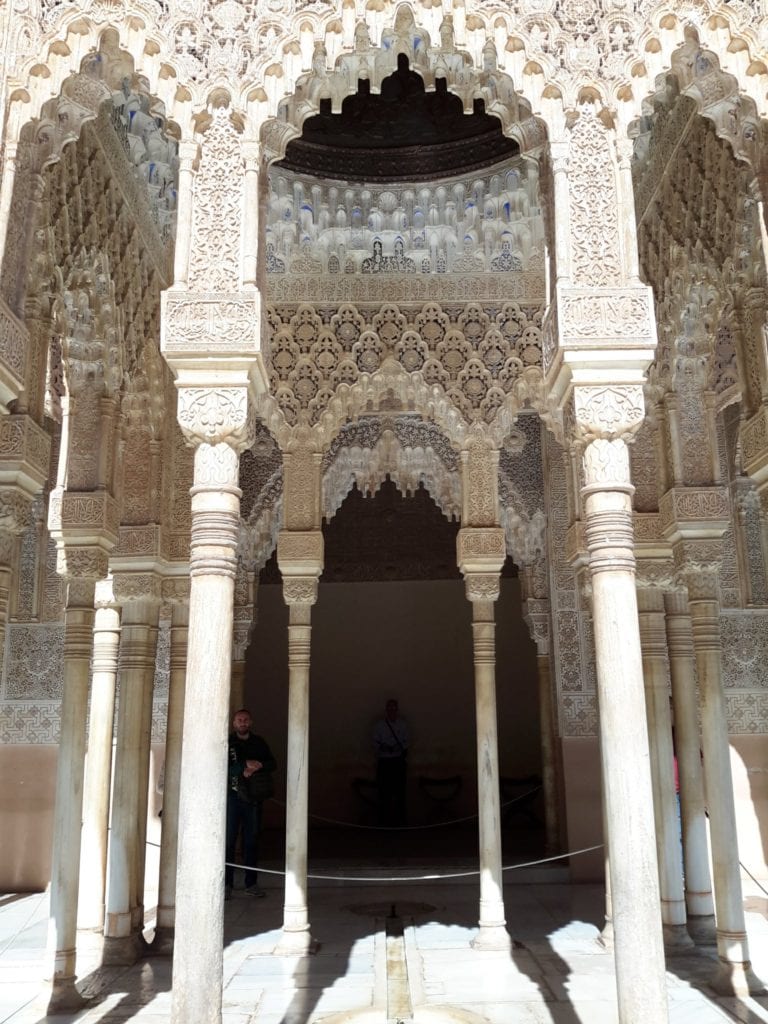
Fountain of the Lions
As you enter the Patio de los Leones (Court of the Lions) you will see it is surrounded by 124 white marble columns which are ornately decorated. They lead to the famous 12 marble lions supporting an alabaster basin. This is the Fuente de los leones (Fountain of the Lions) and are emblems of strength and courage. The Patio is an oblong court 116 feet (35 metres) long and 66 feet (20 metres) wide. The colonnade is paved with white marble and makes the space seem intimate but regal.
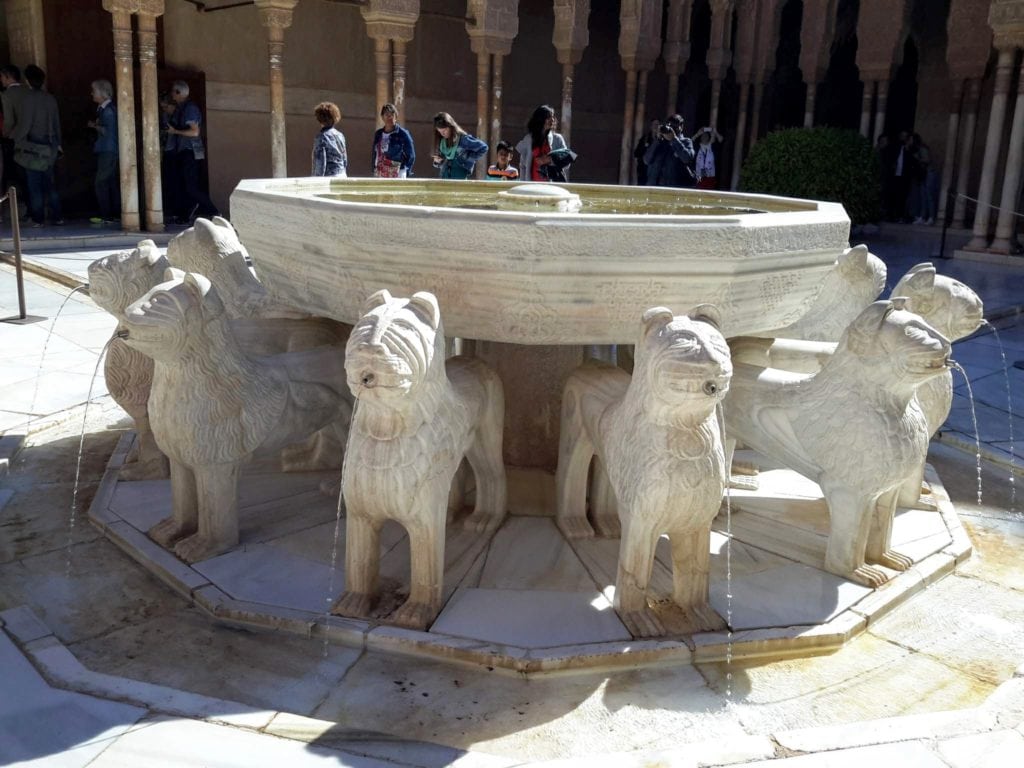
in the centre of the Patio de los Leones (Court of the Lions)
Daraxa’s Mirador
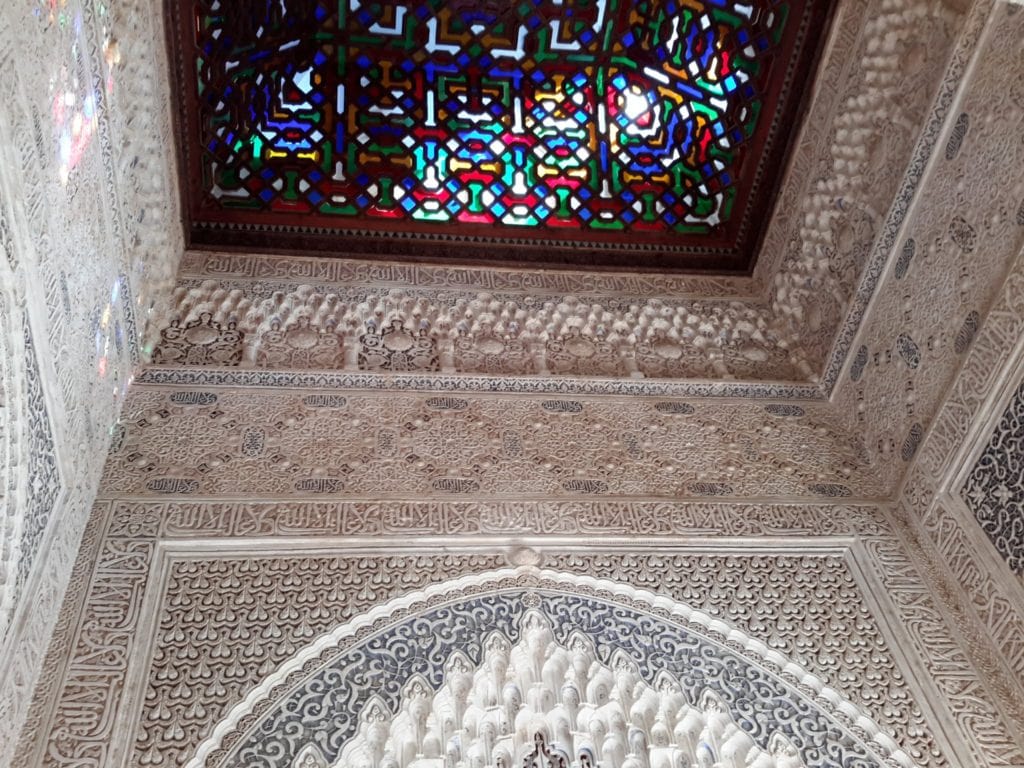
Mirador de Daraxa (Daraxa’s Mirador) is situated in the Sala de Dos Hermanas (Hall of Two Sisters), the Mirador is an intimate space looking out towards Patio de la Lindaraja (a garden). Unlike the other ceilings made of wood, marble or plaster, this one has stained-glass.
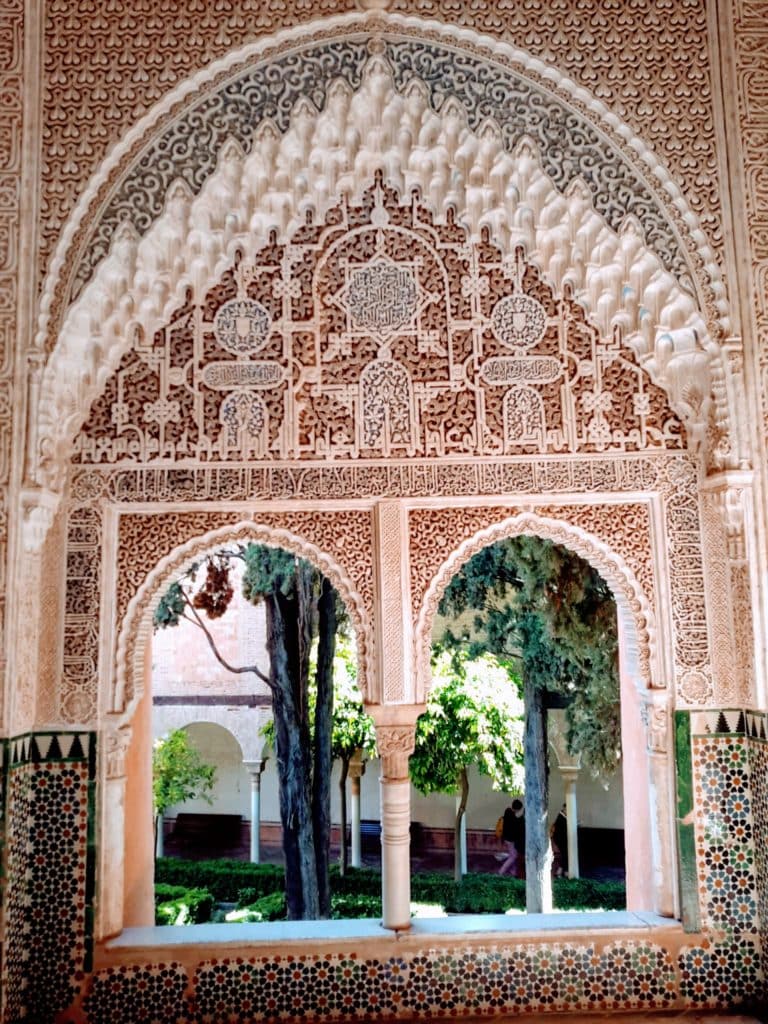
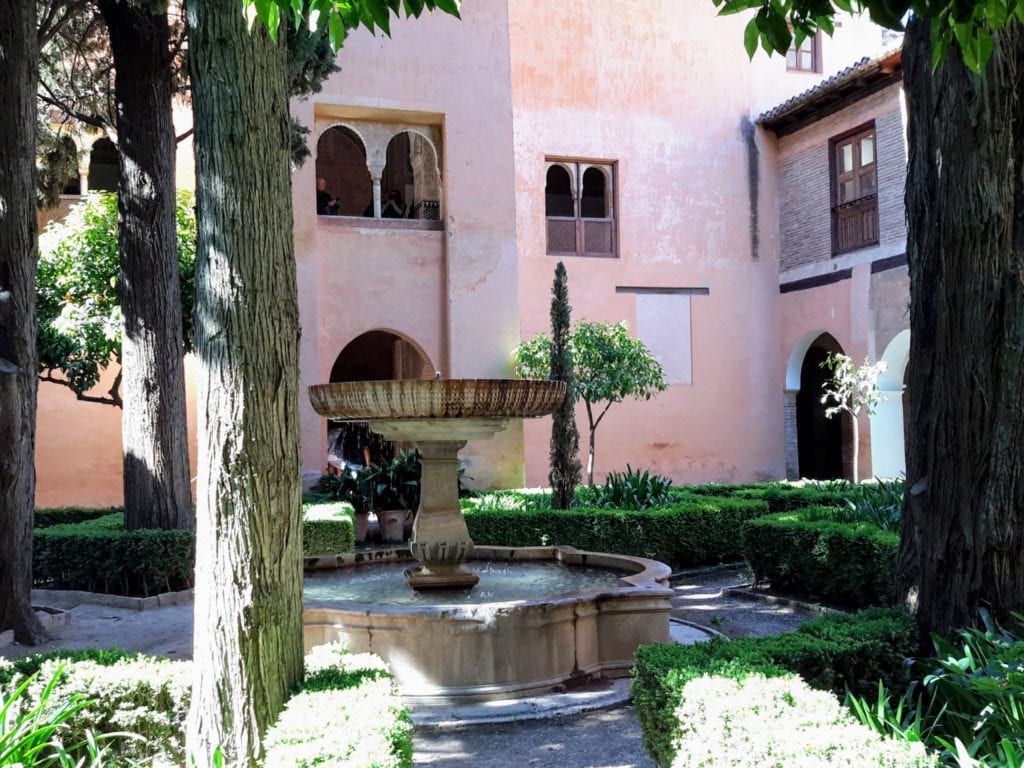
Hall of the Abencerrajes
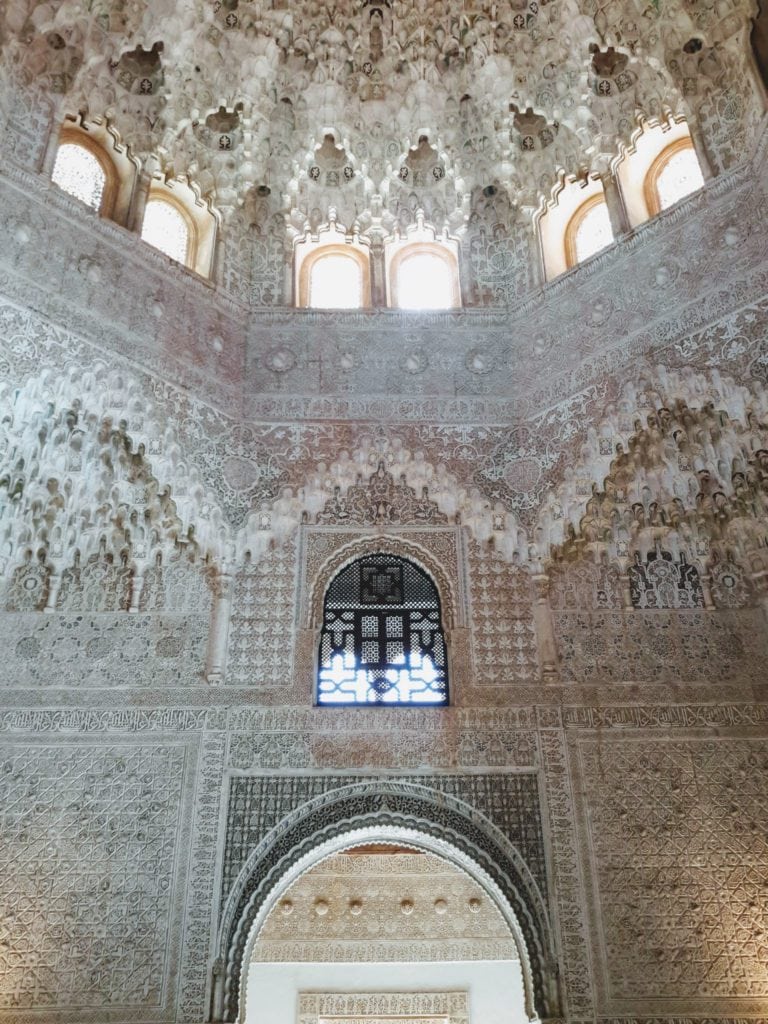
Of the four halls around the Patio de Leones is the Sala de los Abencerrajes (Hall of the Abencerrajes), on the south side, is the most impressive. Boasting a mesmerizing octagonal stalactite ceiling it the muqarnas mimics both honeycombs and stalactites and illustrate the constellations. This is the site of the murders of the noble Abencerraj family, whose leader, the story goes, dared to dally with Zoraya, Abu al-Hasan’s favourite concubine.
The Arabic architecture and design are very intricate but do not have images of living creatures, that, they consider, is the work of God. What you will see is But scripture is written all over the place. “The power is God”, “The glory is God” can be found throughout. One phrase: “Only God is victorious.” is written more than 9,000 times.
Alcazaba
The Citadel or Alcazaba is a skeleton of the military zone of the enclosure. You can visit the terrace of the Torre del Cubo, the Adarve of the north wall, the Plaza de las Armas, with the Barrio Castrense, the terrace of the Puerta de las Armas, the Torre de la Vela and the garden of the Adarves. On our tour we did not visit this part of the Alhambra but you will be able to see incredible views of the Sierra Nevada mountain range and the city of Granada.
Charles V Palace
Lastly, you will want to have a quick tour of the Palacio de Carlos V (Charles V palace).The building is a perfect Renaissance circle in a square. It was meant for gatherings but the king never resided in the Alhambra in Granada. Today it houses two museums: the Museo de la Alhambra, which showcases a collection of Moorish artifacts, including the wood-carved door from the Sala de Dos Hermanas, and the excavated remains of the Acequia Real (Royal Water Channel); and the Museo de Bellas Artes, with 15th- to 20th-century artworks.
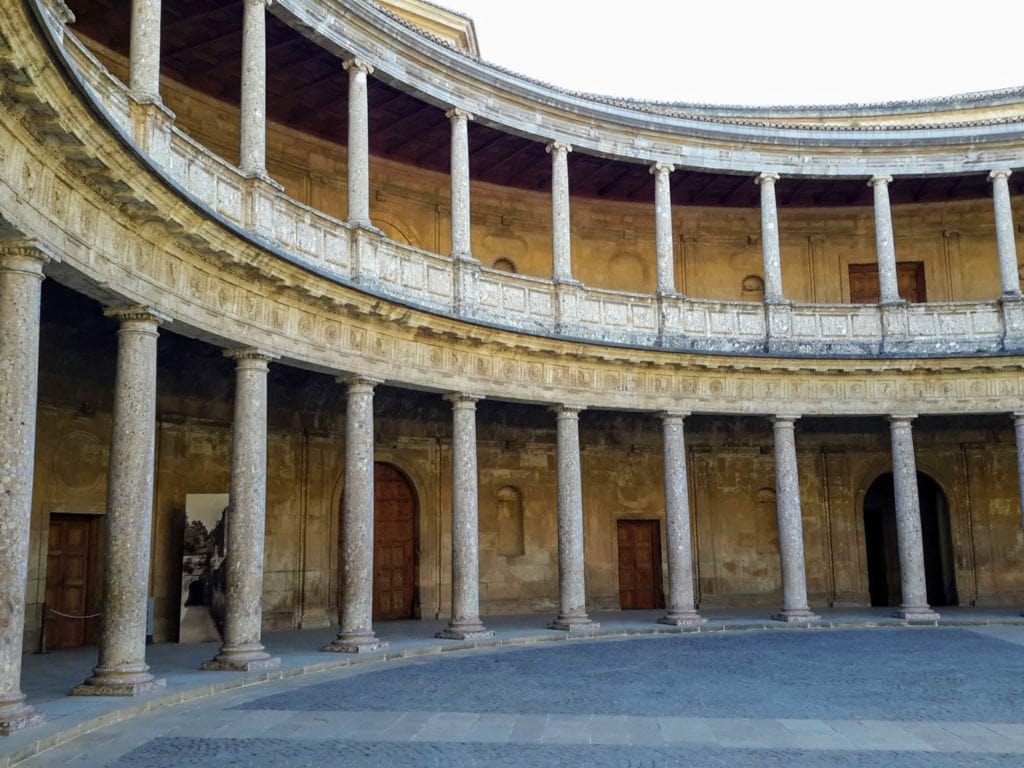
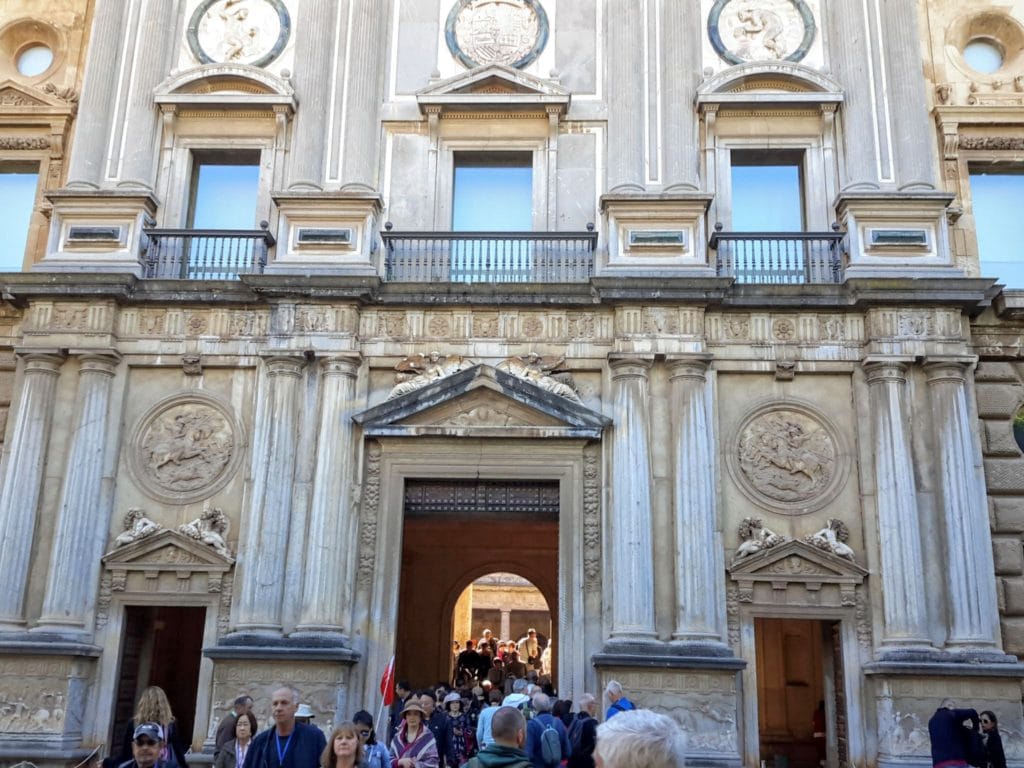
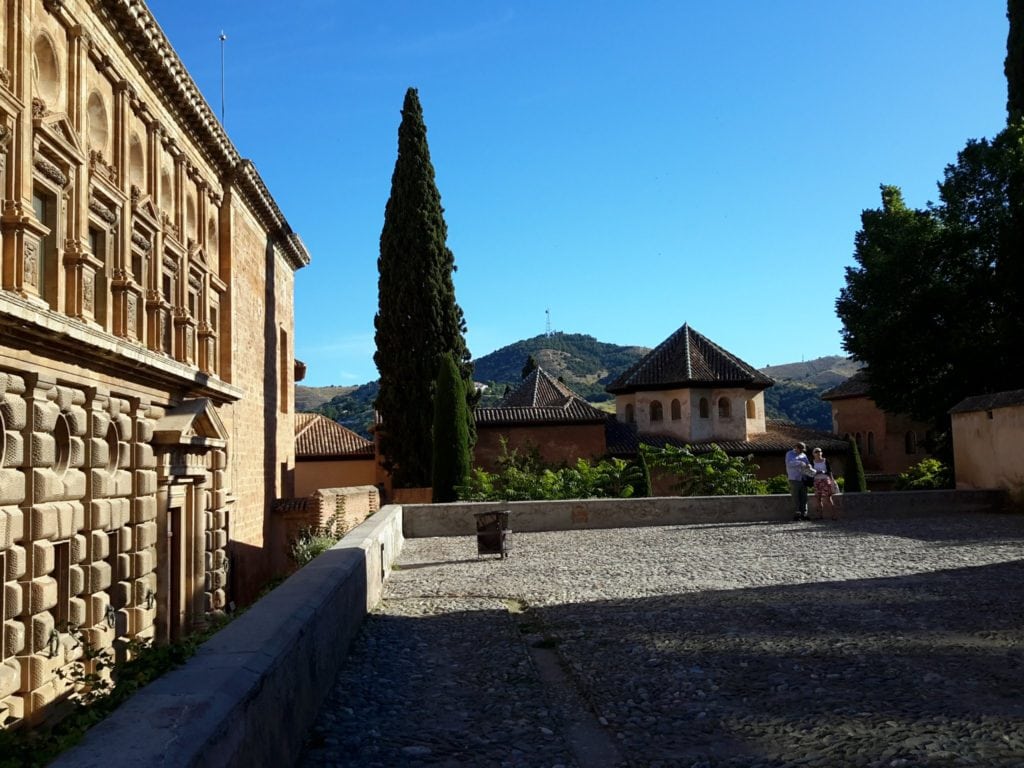
When I planned my trip to Andalusia in southern Spain, I did it with one goal in mind: seeing The Alhambra in Granada. I am so glad I took the time to pick a trip that had this included as a stop. It was one of the highlights of the bus tour. I only wish we had more time to see the citadel and the museums. The solution is returning. I hope to do that soon.
Pin it for later …
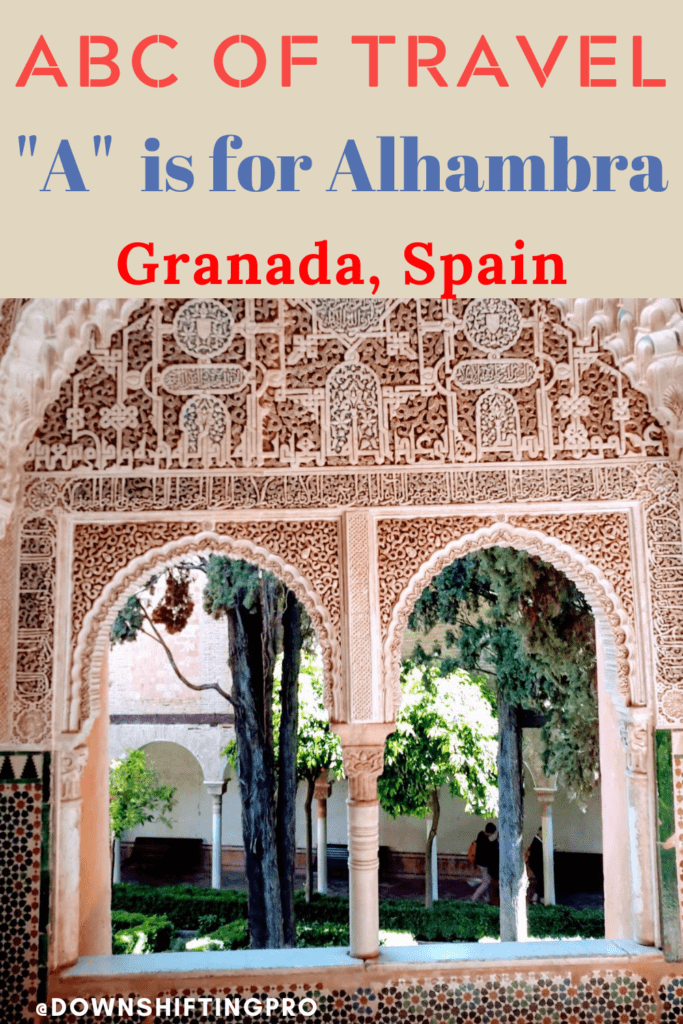
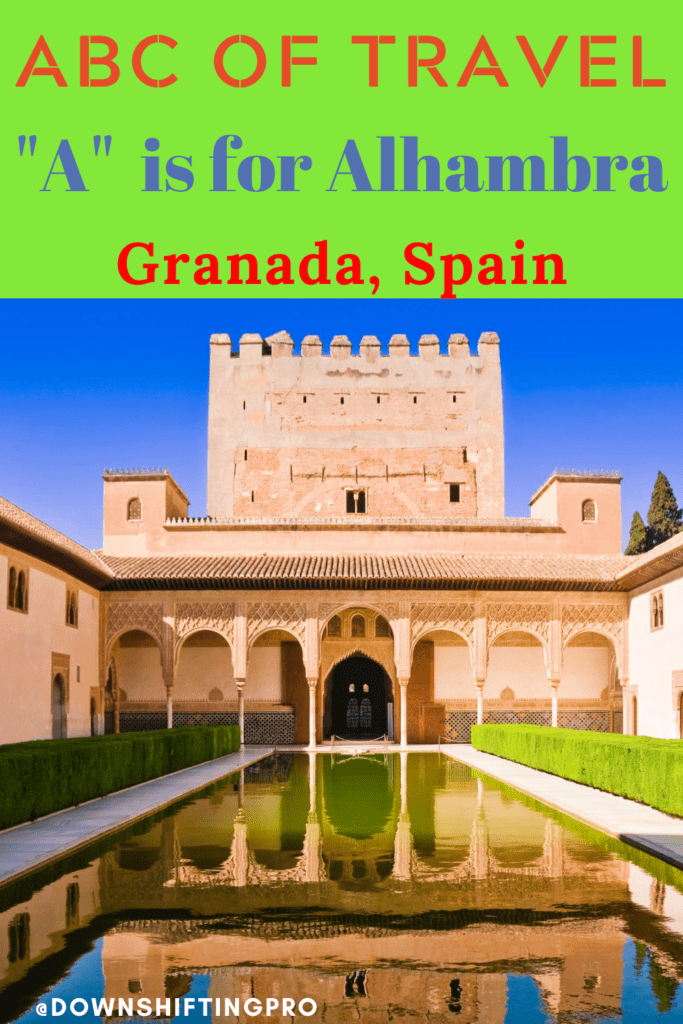
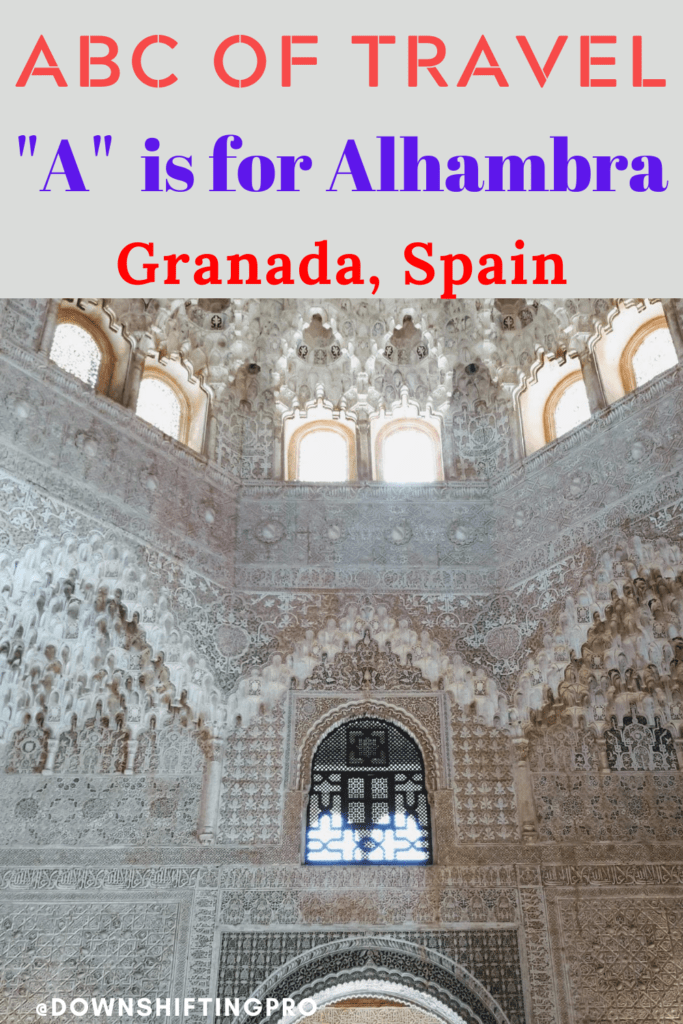
🥾 Explore: Tours & Experiences
🏡 Where to Stay: Top Accommodations
🚙 Hit the Road: Car Rental Deals
🛫 Get Away: Find Flight Deals
🎒 Shop: Travel Essentials
Margarita Ibbott is a travel and lifestyle blogger. She blogs about travel in Canada, the United States and Europe giving practical advice through restaurant, hotel and attraction reviews. She writes for DownshiftingPRO.com and other online media outlets.

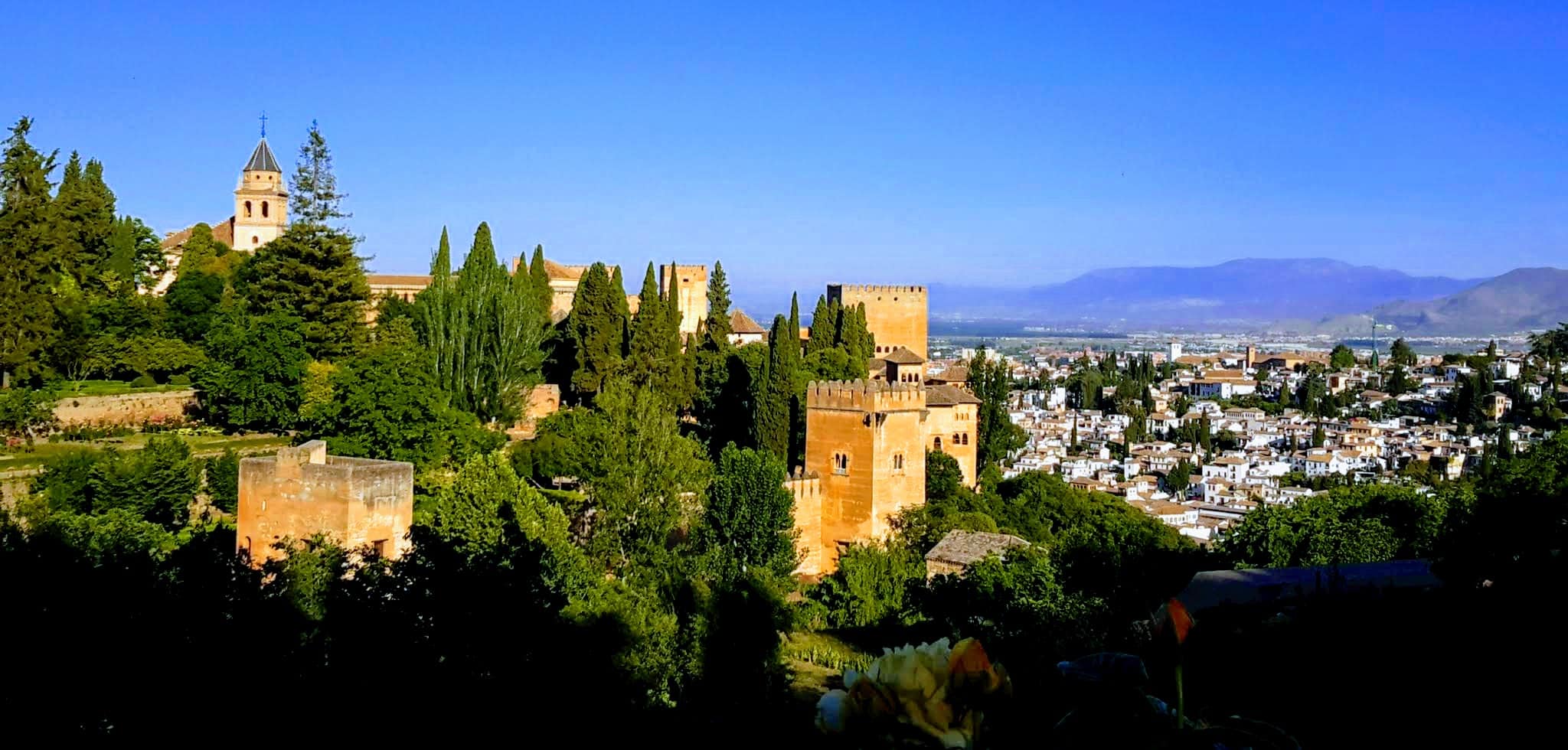
The Alhambra is still on my list of places to visit. I grew up in Spain and it’s definitely one of the most iconic sites in the country. I really need to plan a trip when we’re allowed to travel again.
Sometimes we fail to check out our own backyards and seek adventure in other countries. I know that is the case for me. I would encourage you to see The Alhambra, it is very beautiful and full of history.
Sometimes we fail to check out our own backyards and seek adventure in other countries. I know that is the case for me. I would encourage you to see The Alhambra, it is very beautiful and full of history.
Granada looks like such a beautiful city! I love all of the history there and the buildings. I have yet to visit Spain so this is super high on my list once I am able to travel again 🙂
We stayed in Granada and loved walking around the city. It was just lovely (as most things in Spain are). No question about it, you must go!
I loved the Alhambra so much! It’s such a gorgeous place that evokes all of my memories of Morocco.
I have yet to go to Morocco but I’m watching a Spanish series on Netflix set in Morocco and I would love to visit. Another #bucketlist item for me.
Granada is one of my favorite cities in Spain, and I LOVED the Alhambra! The Generalife was definitely my favorite part.